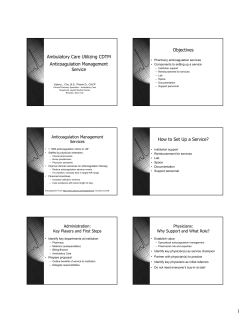
Adverse Drug Events – Excessive Anticoagulation Olympia Medical Center AIM Statement Next Steps
Adverse Drug Events – Excessive Anticoagulation Olympia Medical Center Los Angeles, CA November, 2014 AIM Statement Run Chart Reduce ADE – Excessive Anticoagulation from 2011 baseline by 40% by December 2014. (Baseline = 4.87, AIM = 2.92 by 12/14) 2014 YTD Performance: 0.38 • Expansion of discharge medication counseling procedures. • Develop relationship(s) with anticoagulation clinics surrounding our hospital to provide better continuity of care for patients. discharged on warfarin therapy. Interventions • Communicate with other area hospitals utilizing CPOE and barcoding technology to make sure safeguards in place for high risk medications are optimized. Phase 1: • An Anticoagulation Management Performance Improvement Team was created in late 2011. • Clinical Pharmacist monitoring of all patients receiving warfarin, enoxaparin, intravenous heparin, and other oral anticoagulants on daily basis, regardless of “per pharmacy” order status. • Creation of an easily accessible report for Dietary Department that lists all patients on warfarin therapy to provide appropriate reinforcement of the importance of a consistent diet. • A monthly report is reviewed by the Director of Pharmacy that lists administration dates/times of warfarin and its reversal agent, phytonadione to be analyzed case by case. • Periodic medication use evaluations performed by the Pharmacy Department to ensure proper use of our pharmacist driven warfarin protocol. Phase 2: • Warfarin was removed from automated medication dispensing cabinets and implementation of barcode technology decreased potential for incorrect dose administration. • Automatic INR “pop-up” built into medication ordering system to alert providers and pharmacists of patient’s most recent INR. Next Steps Team Members Data Source: Comprehensive Data System-HRET as of 09-09-2014 Lessons Learned • It is essential that all patients on full anticoagulation be monitored by pharmacists, not only the patients on pharmacy driven protocols. • Case by case analysis is essential for all patients requiring warfarin reversal to pinpoint system errors and formulate improvement plans. • Anticoagulation must be included as a key topic in yearly clinical pharmacist competency assessment. • Multidisciplinary involvement/cooperation essential for reduction in excessive anticoagulation. Resources • HQI ADE Harm Elimination Toolkit is available on the HQI website at hqinstitute.org < Tools and Resources. • Questions: Contact Mahsa Farahani, Project Manager, HQI at 916-552-7521, email mfarahani@hqinstitute.org. • Anticoagulation Performance Improvement Team: • Director of Pharmacy: Dr. Annette Marquez, PharmD • Chair of the Pharmacy & Therapeutics Committee: Dr. Alfred Rahban, MD • Informatics Pharmacist: Dr. Lisa Preimesberger, PharmD • Clinical Pharmacist: Dr. Jordan Yingling, PharmD • Director of Case Management: Quiana Hines, RN • Registered Dietitian: Emilia Janeke, RD
© Copyright 2025





















